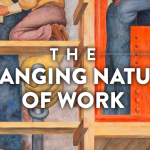The 40 factors which create a positive working culture

New research from Accenture argues that creating a culture of equality in an organisation or firm tends to unlock human potential and create a more positive workplace culture in which everyone can advance and thrive.
The report acknowledges that workplace culture is complex and fluid, making it hard to define and influence. However the measure of an organisation’s success in creating more productive working environments does not lay in the number of policies they produce but the employee experience they create and their effect on employee creativity and productivity.
While there are a number of social and economic barriers to equality in the workplace, from educational disparities and childcare and domestic responsibilities to cultural biases, an organization’s culture can hold back women as well.
Accenture surveyed more than 22,000 working men and women with a university education in 34 countries to assess their views of their workplace culture. Respondents identified over 200 different personal and workplace factors, including the policies, behaviors and collective opinions of employees. 40 of these appeared to be statistically significant influencers of change, and 14 factors emerged as the most important.
Organisations which exhibited these 40 factors had four times as many women in senior management roles. If every firm followed suit, then 84 females would reach management roles for every 100 men, compared to just 34 today. Furthermore, female pay would increase by just over half, equating to a boost in women’s earnings around the world of US$2.9 trillion.
The factors for success can be grouped into three main areas.
Bold Leadership involving a diverse leadership team that sets, shares and measures equality targets openly.
Gender diversity should be a priority for management and they should set a diversity goal which is shared outside the organization. The organization should itemise and admit gender pay gaps and set ambitions to rectify them.
Comprehensive action to create policies and practices that are family-friendly, support both genders and attract and retain people in an unbiased way.
This action should include measures of progress made in attracting, retaining and progressing women. While many successful companies created a women’s network, the most successful ones opened it to men and encouraged men to take parental leave as well as women. Firms where men took parental leave reduced or eliminated the career stalling effects such breaks can have for women.
An empowering environment which trusts employees, respects individuals and offers freedom to be creative and to train and work flexibly.
The factors which created an empowering, and therefore creative and committed working environment were perhaps the most interesting. While it might be expected that top performing organisations offer training to keep their employees’ skills fresh and relevant, less obvious factors such as clothing were also significant.
Employees who were allowed to choose their own attire, rather than conform to an explicit or implied company dress code tended to be more creative, just as those who were encouraged to be innovative, rather than discouraged from trying new approaches to tasks, produced more ideas.
The most successful firms also encouraged virtual and remote working and reaped the benefits of it through common practise, rather than insisting on ‘presenteeism’. They allowed their employees to concentrate on their work and maintain their home lives by encouraging virtual meetings, for example, rather than insisting on arduous, expensive and tiring long distance travel. They also allowed employees to work at home on a day they had a pressing personal commitment, rather than insist they turned up at the office regardless.
Tellingly, in the light of the #meetoo movement, firms where employees felt comfortable reporting sex discrimination or sexual harassment incidents to senior staff had better working cultures. However nearly one-third of men and women believed that the frequency of sexual harassment and sex discrimination in their work environment had remained the same or worsened since five years ago or when they first joined the organization.
Unfortunately, almost half of the women surveyed said their organization has either made no change in reducing tolerance of sex discrimination or had presided over a deterioration in that time.
Achieving success in all three categories creates a virtuous circle, with each one enhancing the others so that, when combined, they deliver an even greater impact than they would in isolation. Together, they nurture a culture of purpose, accountability, belonging, trust and flexibility.
These factors were found to benefit men as well as women, rather than equal rights being seen as a zero sum game. In environments where the 40 factors were most common, men were 23% more likely to advance to manager level and beyond, and more than twice (118%) as likely to advance to senior manager or director level and beyond than are men in environments where these factors were less common.
However where the 40 factors are most common, women’s odds of progress improve more than men’s do, which helps to close the gender gap in advancement and pay.
The 40 factors which differentiate the best companies
Bold Leadership
1. Gender diversity is a priority for management.
2. A diversity target or goal is shared outside the organization.
3. The organization clearly states gender pay-gap goals and ambitions.
4. Progress on gender diversity is measured and shared with employees.
5. Leaders are held accountable for improving gender diversity.
6. A diversity target or goal is shared inside the organization.
7. The leadership team is diverse.
Comprehensive Action
8. Progress has been made in attracting, retaining and progressing women.
9. The company has a women’s network.
10. The company’s women’s network is open to men.
11. Men are encouraged to take parental leave.
12. Employees trust that the organization pays women and men equally for the same work.
13. The proportion of women in senior leadership has increased over the last five years.
14. The organization is fully committed to hiring, progressing and retaining women.
15. Progress has been made in improving gender equality in senior leadership.
16. There is a clear maternity policy in place.
17. Women are encouraged to take maternity leave.
18. There is a clear parental policy in place.
19. The organization hires people from a variety of backgrounds.
20. Leaders take action to get more women into senior roles.
An Empowering Environment
21. Employees have never been asked to change their appearance to conform to company culture.
22. Employees have the freedom to be creative and innovative.
23. Virtual/remote working is widely available and is common practice.
24. The organization provides training to keep its employees’ skills relevant.
25. Employees can avoid overseas or long-distance travel via virtual meetings.
26. Employees can work from home on a day when they have a personal commitment.
27. Employees are comfortable reporting incidents of sex discrimination or sexual harassment to the company.
28. Employees feel trusted and are given responsibility.
29. Employees have the freedom to be themselves at work.
30. Leadership has a positive attitude toward failure.
31. Leaders set a positive example around work–life balance.
32. Networking events with company leaders take place during office hours.
33. Employees can decline a request to work later without negative consequences.
34. Employees can decline a request to attend early-morning/late-evening meetings without negative consequences.
35. Sex discrimination and sexual harassment is not tolerated at work.
36. The company has made progress in reducing tolerance of sex discrimination or gender-biased language.
37. Company training times and formats are flexible.
38. Supervisors respond favorably to flexible working requests.
39. The organization respects employees’ needs to balance work with other commitments.
40. The organization has made progress on building a workplace where no one feels excluded.








